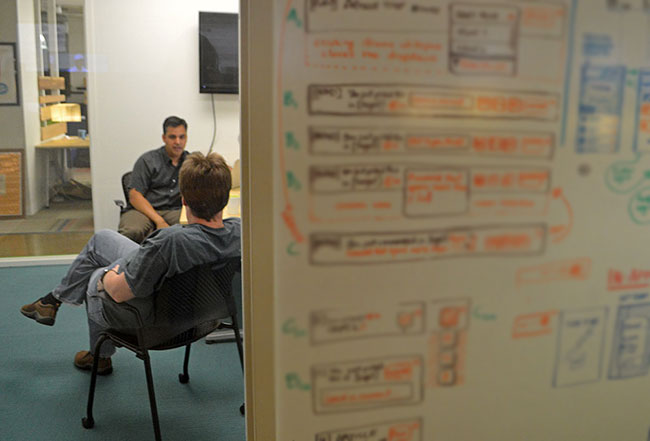
Image from dry-erase company ideapaint
When architects look at the built environment today, it can't help but be with profound misgivings. They're still working on projects, but the most ambitious designers are concentrating on building out, rather than building up, on moving people through interfaces rather than cities. Foundations and blueprints are replaced by schematics and entity relationship maps: architectures not of form, but of information. The fundamental unit of design isn't so much a site as it is a platform. And today, engineering a new society involves relentless ideation, a messianic vision, and—most crucially—a whiteboard.
"Whiteboarding," used as a verb, is a sort of lingua franca of the technologist—a new international style that reconstitutes the very assumptions of digital design, from interfaces and software diagrams to database structures. Though not new, this apparatus has recently become associated with a new kind of creative, a new type of thinker/tinkerer, and thus the whiteboard takes on new meaning vis-a-vis the economy, privilege, and power. Used and abused, it is a significant artifact of the present age of networked capital. If we were to construct a museum-like period room to represent the tech start-up of the new millennium, its walls would be whiteboards.
Network diagrams, interface mockups, and data models are just a few of the more popular subjects that have helped install the whiteboard as a staple of the high-tech office environment. Now, the whiteboard is ubiquitous not only in big technology firms, but more specifically in the small startup operations whose seeds of disruption are planted in dry erase marker. Few offices exist without them, but in the breakneck world of the digital startup, they're more than just prevalent: they form the very DNA of the organization.
What is on the whiteboard is less interesting than the behavior it generates. The whiteboard's contents appear precisely because they will soon be obsolete, deprecated, upgraded, and abandoned. The social bodies it distributes, however, which run the gamut from institutions and law, markets and exchanges, remain. Like Utopia, the whiteboard charts that which can only ever disappear—not a real landscape, but a figment of a collective imagination, the new work of capitalism.
No one seems to be sure exactly when the whiteboard arrived in the office. Sometime in the 1970s, there was a waning of enthusiasm for the chalkboard, its direct predecessor. Chalk dust bothered some students, and likewise was unwelcome inside the clean corporate aesthetic that emerged alongside the renaissance in management ideology during the 1970s. One could speculate that the whiteboard emerged as a welcome apparatus in what Luc Boltanski and Eve Chiapello have termed "The New Spirit of Capitalism:" the lean, networked system that attempted to synthesize the lessons of "68" by adopting flat organization, autonomy, and an ethos of teamwork.
But why is this the case? The whiteboard is open, exploratory; it is weak in its commitments but bold in its designs. If the chalkboard is didactic and pedagogical, the whiteboard is a liberated zone for "ideation" whose markings do less to edify than to solve the problems they simultaneously invent.
The whiteboard is defined by what it does not show. The bold and economical line of the whiteboard marker is a visual manifestation of the values of the innovator: a momentary stage for the most audacious founder's vision. Its clean white slate creates a sort of vacuous political economy, depicting not bureaucracy, government regulations, nor—critically—human labor.

Image from Veber hosting solutions
As many an inked hand attests, the content of the whiteboard appears and disappears whenever inspiration strikes. Its designs have short lifespans, their utility measured with each new scrum, ideation session, or team lunch. Putting in time with a whiteboard is a constant rehearsal, an ever-renewing production to re-mythologize one's management vision, even if it's tackling a mundane problem.
The good founder will use the whiteboard to articulate almost any idea.
When you walk through the open office plan of an incubator, co-working space, or quirky startup office, the whiteboard functions as an open demonstration of solutionism and productivity. The whiteboard says "Hey, come look what we're working on!" from a group of would-be founders who are never more than 3 months away from a VC pitch.
Using a whiteboard is always a performance. It does not inscribe authority, but erects a power-knowledge system that makes abstract concepts seem concrete, where you can present mere ideas as monetizable. It is a visible symptom of a focused collective imagination increasingly structured around software interfaces. Connections are APIs, gateways are logins, and the content is data. One always arrives at a blank whiteboard already knowing one will leave with a solution. On the whiteboard, things just appear to make sense.
If something like the 16th-Century tapestry implied an institutionalization of its patrons through myth and fantasy, then today the neoliberal technologist uses the whiteboard to collaborate their way to an even grander hyper-fiction, to instantly traverse new speculative landscapes whose rules and structures can be remodeled on the fly. However, the whiteboard swathes itself in the same rhetoric as the sharing economy—collaborative, flat, democratic. Anyone can walk up and inscribe themselves into the organization. The whiteboard is a tool for crisis, for change, loose affinities and cool collectivities, for historical fabric defined by onboarding new users and meted out in disruptions. In the age of the instant entrepreneur, it's our blank canvas.
Idea paint @Paypal

